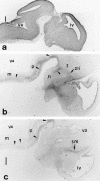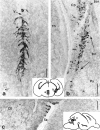The distribution of heat shock proteins in the nervous system of the unstressed mouse embryo suggests a role in neuronal and non-neuronal differentiation
- PMID: 11048652
- PMCID: PMC312859
- DOI: 10.1379/1466-1268(2000)005<0291:tdohsp>2.0.co;2
The distribution of heat shock proteins in the nervous system of the unstressed mouse embryo suggests a role in neuronal and non-neuronal differentiation
Abstract
Heat shock proteins (Hsps) act as molecular chaperones and are generally constitutively expressed in the absence of stress. Hsps are also inducible by a variety of stressors whose effects could be disastrous on the brain. It has been shown previously that Hsps are differentially expressed in glial and neuronal cells, as well as in the different structures of the brain. This differential expression has been related to specific functions distinct from their general chaperone function, such as intracellular transport. We investigated here the constitutive expression of 5 Hsps (the small Hsp, Hsp25, the constitutive Hsc70 and Hsp90beta, the mainly inducible Hsp70 and Hsp90alpha), and of a molecular chaperone, TCP-1alpha during mouse nervous system development. We analyzed, by immunohistochemistry, their distribution in the central nervous system and in the ganglia of the peripheral nervous system from day 9.5 (E9.5) to day 17.5 (E17.5) of gestation. Hsps are expressed in different cell classes (neuronal, glial, and vascular). The different proteins display different but often overlapping patterns of expression in different regions of the developing nervous system, suggesting unique roles at different stages of neural maturation. Their putative function in cell remodeling during migration or differentiation and in protein transport is discussed. Moreover we consider Hsp90 function in cell signaling and the role of Hsp25 in apoptosis protection.
Figures










Similar articles
-
Constitutive expression of heat shock proteins Hsp90, Hsc70, Hsp70 and Hsp60 in neural and non-neural tissues of the rat during postnatal development.Cell Stress Chaperones. 1998 Sep;3(3):188-99. doi: 10.1379/1466-1268(1998)003<0188:ceohsp>2.3.co;2. Cell Stress Chaperones. 1998. PMID: 9764759 Free PMC article.
-
Purification of multiple heat shock proteins from a single tumor sample.J Immunol Methods. 2000 Apr 3;237(1-2):119-30. doi: 10.1016/s0022-1759(00)00137-x. J Immunol Methods. 2000. PMID: 10725457
-
Cultured skin fibroblasts isolated from mice devoid of the prion protein gene express major heat shock proteins in response to heat stress.Exp Neurol. 1998 May;151(1):105-15. doi: 10.1006/exnr.1998.6796. Exp Neurol. 1998. PMID: 9582258
-
Heat shock and the role of the HSPs during neural plate induction in early mammalian CNS and brain development.Cell Mol Life Sci. 1997 Feb;53(2):198-211. doi: 10.1007/pl00000592. Cell Mol Life Sci. 1997. PMID: 9118008 Free PMC article. Review.
-
Molecular chaperones and their roles in neural cell differentiation.Dev Neurosci. 2002;24(1):1-13. doi: 10.1159/000064941. Dev Neurosci. 2002. PMID: 12145406 Review.
Cited by
-
Exploring the Ocular Surface Microbiome and Tear Proteome in Glaucoma.Int J Mol Sci. 2024 Jun 6;25(11):6257. doi: 10.3390/ijms25116257. Int J Mol Sci. 2024. PMID: 38892444 Free PMC article.
-
Mammalian HspB1 (Hsp27) is a molecular sensor linked to the physiology and environment of the cell.Cell Stress Chaperones. 2017 Jul;22(4):517-529. doi: 10.1007/s12192-017-0765-1. Epub 2017 Jan 31. Cell Stress Chaperones. 2017. PMID: 28144778 Free PMC article. Review.
-
Small heat-shock proteins and their role in mechanical stress.Cell Stress Chaperones. 2020 Jul;25(4):601-613. doi: 10.1007/s12192-020-01095-z. Epub 2020 Apr 6. Cell Stress Chaperones. 2020. PMID: 32253742 Free PMC article. Review.
-
TRACING CO-REGULATORY NETWORK DYNAMICS IN NOISY, SINGLE-CELL TRANSCRIPTOME TRAJECTORIES.Pac Symp Biocomput. 2017;22:576-587. doi: 10.1142/9789813207813_0053. Pac Symp Biocomput. 2017. PMID: 27897008 Free PMC article.
-
Role of a Heat Shock Transcription Factor and the Major Heat Shock Protein Hsp70 in Memory Formation and Neuroprotection.Cells. 2021 Jun 29;10(7):1638. doi: 10.3390/cells10071638. Cells. 2021. PMID: 34210082 Free PMC article. Review.
References
-
- Altman J, Bayer SA. Development of the brain stem in the rat. I. Thymidine-radiographic study of the time of origin of neurons of the lower medulla. J Comp Neurol. 1980;194:1–35. - PubMed
-
- Altman J, Bayer SA. The development of the rat hypothalamus. Adv Anat Embryol Cell Biol. 1986;100:1–178. - PubMed
-
- Altman J, Bayer SA 1995 Atlas of Prenatal Rat Brain Development. CRC Press, Boca Ràton, FL.
-
- Aquino DA, Klipfel AA, Brosnan CF, Norton WT. The 70-kDa heat shock cognate protein (HSC70) is a major constituent of the central nervous system and is up-regulated only at the mRNA level in acute experimental autoimmune encephalomyelitis. J Neurochem. 1993;61:1340–1348. - PubMed
Publication types
MeSH terms
Substances
LinkOut - more resources
Full Text Sources
Research Materials
Miscellaneous
